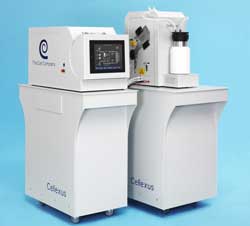
Posted to News on 30th Nov 2009, 11:34
PLCs and HMI control innovative bioreactors
I4Innovation uses four Mitsubishi Electric Alpha PLCs and a GT15 HMI in the bioreactors that it manufactures for growing cell cultures.

Today's entry-level PLCs (programmable logic controllers) possess remarkable processing power, and this is being harnessed by a self-taught control engineer who is using them to manage the growth of cell cultures in bioreactors.
Lee Pettitt of I4Innovation in Thetford has married four Mitsubishi Electric Alpha controllers with the powerful GT15 HMI (human machine interface) from the same company to monitor and adjust pumps, impellers, inlet and outlet valves and multiple sensors in the reactors. In a parallel process, the control system also manages the production of nitrogen and oxygen from the atmosphere for use in the reactor.
He gives some background: "Cell cultures are vital in many fields of modern medicine, from pharmaceuticals to skin grafts and organ transplants, dialysis and high-intensity neonatal procedures. There are four basic types of culture: insect, mammalian, yeast and E.Coli, each with literally thousands of variations to meet specific needs for individual cases."
Recipes management and digital signatures
Pettitt's system stores precise recipes on the HMI, which is also used for real-time process control and comprehensive data logging and Digital Signature Management to meet the stringent requirements of the FDA's CFR21 part 11 rules.
In use, the various components of the chosen recipe are introduced to the reactor via inlet valves and are circulated through an aqueous media at an optimal rate to promote growth of the culture. Temperature is usually critical and sometimes pressure, dissolved oxygen and pH are too. Usually oxygen, nitrogen or carbon dioxide are introduced at a controlled rate in order to promote growth.
Impellers keep the solution circulating and measurements are taken from several monitoring points to check the conditions are correct for cell growth. Temperature, pressure and exposure to light can also be monitored and adjusted.
Gas production
Beside the reactors a Pressure Swing Absorption system can be activated to separate and compress nitrogen and/or oxygen from the atmosphere for use in cell growth.
Pettit explains: "Most other bioreactors use bottled gases, but this leads to an extra cost, plus a considerable bottle management effort. This gives users of our equipment a distinct advantage, although we still have to use bottles for carbon dioxide."
The bioreactors have 32 inputs and 24 outputs, plus eight analogue outputs, all handled by Mitsubishi Alpha mini controllers. Most people expect to see a far larger rack PLC at the heart of the control system and so are delighted with the simplicity of the hardware. They recognise that it is far less costly to buy, run and maintain, and easier to reconfigure if user requirements change.
Alpha better
Pettitt continues: "I discovered Alphas about six years ago and now hardly ever use anything but. When used to their full capacity they are very powerful, and every succeeding new version is even more powerful. There is a clarity to the way they are programmed and I have converted several older control systems from larger PLCs to Alphas - usually improving performance and certainly never compromising it."
Part of his success is due to the fact that he often uses them in conjunction with a state-of-the-art HMI, as is the case with the bioreactors.
Pettitt says: "HMIs are very versatile and can be a powerful addition to a control system. I work hard to develop user-friendly graphics with them, trying to see the machine operation and process sequence from the operator's point of view, rather than from the control system developer's position. This can require some mental gymnastics on my part, but there are some tricks of the trade - like letting the potential operators tell me what they want, rather than me trying to explain the systems to them."
Housing design
In fact the HMI is often the key selling point for Pettitt and his colleagues. I4Innovation makes the bioreactors housings in-house using a fabrication technique, rather than buying in moulded ones. "We put the HMI in a separate housing, which is pivot-mounted to the main housing so that operators can adjust the viewing angle. Its a little point, but every potential customer nearly always comment favourably on it."
Like the Alphas, the HMIs get steadily better and Pettitt is currently assessing the new-generation Mitsubishi GT16, which has, amongst other advances, more memory and a high-resolution screen. "We are going to do a video version of the user manual and embed it into the GT16. This will allow bioreactor operators complete autonomy, so in theory anybody will be able to plug them in and teach themselves everything they need to know."
Follow the links for more information about the Mitsubishi Alpha controller and HMIs.
Want the latest machine building news straight to your inbox? Become a MachineBuilding member for free today >>

















